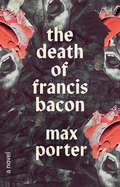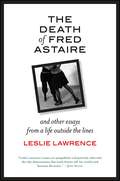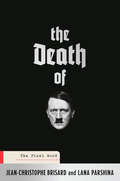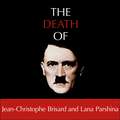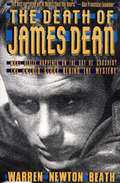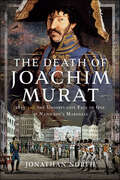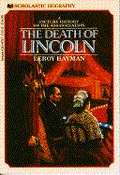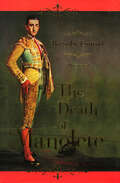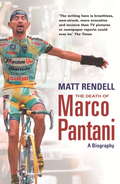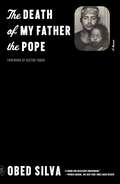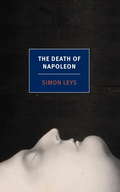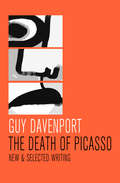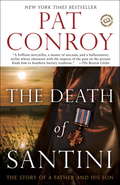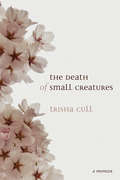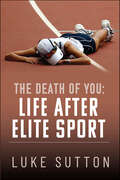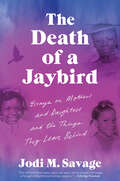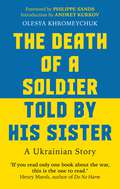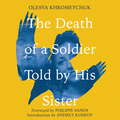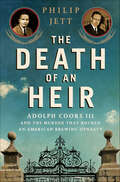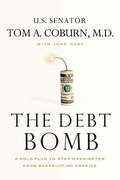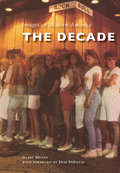- Table View
- List View
The Death of Elizabeth I
by Catherine LoomisThe death of Queen Elizabeth I in 1603 was greeted by an outpouring of official proclamations, gossip-filled letters, tense diary entries, diplomatic dispatches, and somber sermons. English poets wrote hundreds of elegies to Elizabeth, and playwrights began bringing her onto the stage. This book uses these historical and literary sources, including a maid of honor's eyewitness account of the explosion of the Queen's corpse, to provide a detailed history of Elizabeth's final illness and death, and to show Elizabeth's subjects - peers and poets, bishops and beggars, women and men - responding to their loss by remembering and reconstructing their Queen. "
The Death of Francis Bacon: A Novel
by Max PorterMadrid. Unfinished. Man dying.A great painter lies on his deathbed, synapses firing, writhing and reveling in pleasure and pain as a lifetime of chaotic and grotesque sense memories wash over and envelop him.In this bold and brilliant short work of experimental fiction by the author of Grief Is the Thing with Feathers and Lanny, Max Porter inhabits Francis Bacon in his final moments, translating into seven extraordinary written pictures the explosive final workings of the artist's mind. Writing as painting rather than about painting, Porter lets the images he conjures speak for themselves as they take their revenge on the subject who wielded them in life. The result is more than a biography: The Death of Francis Bacon is a physical, emotional, historical, sexual, and political bombardment--the measure of a man creative and compromised, erotic and masochistic, inexplicable and inspired.
The Death of Fred Astaire: And Other Essays from a Life outside the Lines (Excelsior Editions)
by Leslie LawrenceFinalist for the 2016 Foreword INDIES Book of the Year Award in the Autobiography & Memoir categoryAs a child of the sixties, Leslie Lawrence knew she didn't want to duplicate her parents' lives, yet she never imagined she'd stray so far outside the lines of their—and her own—expectations.The Death of Fred Astaire opens with the story, both wrenching and funny, of how Lawrence says her goodbyes to the iconic images she's held since her youth; she then proceeds to bear a child and raise him with her lesbian partner. Some essays in this debut collection reflect on legacies Lawrence inherited from her Jewish family and culture. In others, she searches gamely for a rich, authentic life—a voice, a vocation, a community, even a "god" she can call her own.Always a seeker, an adventurer resisting fear, Lawrence, a city girl, creates a summer home in the back woods of the "Live Free or Die" state. She attempts the flying trapeze and takes part in a cross-dressing workshop. Traveling alone to Morocco, she assists a veterinarian tending to an ailing donkey. Teaching in a vocational high school in Boston, she questions her methods and assumptions about race and class. With rare honesty, she confronts the complexities of motherhood, of caring for her ill partner, and of widowhood. In "Wonderlust," the collection's most ambitious piece, she explores the role of beauty and creativity in our spiritual lives, revealing how lifelong learning in dance, music, and the visual arts can make us all more alive even as we age.Ranging widely in length, subject, and style, these personal essays place Lawrence among today's most vital writers of creative nonfiction. Her warmth and wisdom, her distinctive blend of humor and pathos, her reverence for what sustains us—food and family, community and beauty—all make this a book you'll want to share with those you love.
The Death of Hitler: The Final Word
by Jean-Christophe Brisard Lana ParshinaOn April 30, 1945, Hitler committed suicide in his bunker as the Red Army closed in on Berlin. Within four days the Soviets had recovered his body. But the truth about what the Russian secret services found was hidden from history, when, three months later, Stalin officially declared to Truman and Churchill that Hitler was still alive and had escaped abroad. Reckless rumors about what really happened to Hitler began to spread like wildfire and, even today, they have not been put to rest. Until now.In 2017, after two years of painstaking negotiations with the Russian authorities, award-winning investigative journalists Jean-Christophe Brisard and Lana Parshina gained access to confidential Soviet files that finally revealed the truth behind the incredible hunt for Hitler's body.Their investigation includes new eyewitness accounts of Hitler's final days, exclusive photographic evidence and interrogation records, and exhaustive research into the power struggle that ensued between Soviet, British, and American intelligence services. And for the first time since the end of World War II, official, cutting-edge forensic tests have been completed on the human remains recovered from the bunker graves--a piece of skull with traces of a lethal bullet, a fragment of bone, and teeth.In The Death of Hitler--written as thrillingly as any spy novel--Brisard and Parshina debunk all previous conspiracy theories about the death of the Führer. With breathtaking precision and immediacy they penetrate one of the most powerful and controversial secret services to take readers inside Hitler's bunker in its last hours--and solve the most notorious cold case in history.
The Death of Hitler: The Final Word on the Ultimate Cold Case: The Search for Hitler's Body
by Jean-Christophe Brisard Lana ParshinaA dramatic and revelatory new account of the final days in Hitler's bunker, based on new access to previously unseen Soviet archives, previously unseen materials, and cutting edge forensics.After two years of nonstop negotiations with the Russian authorities, Jean-Christophe Brisard and Lana Parshina were granted access to secret files detailing the Soviets' incredible hunt to recover Hitler's body: the layout of the bunker, plans for escaping, eyewitness accounts of the Führer's final days, and human remains-a bit of skull with traces of the lethal bullet and a fragment of jaw bone. For the first time, the skull, teeth and other elements were analysed by a medical examiner with cutting edge forensics equipment. The authors use these never before seen documents and research to reconstruct the events in fascinating new detail.(P)2018 Hodder & Stoughton Limited
The Death of James Dean
by Warren Newton BeathWith extensive research, this account of the Hollywood star and his legion of fans offers “the best narrative yet of Dean’s final ten hours” (San Francisco Examiner). Just before sunset on September 20, 1955, James Byron Dean’s Porsche 550 Spyder collided with Donald Gene Turnupseed’s Ford Tudor on California Highway 46. At age twenty-four, America’s newest screen idol was dead. But what really happened? Drawing on original documents, including the coroner’s inquest and other previously unpublished material, author Warren Newton Beath provides a painstakingly accurate reconstruction of Dean’s final hours and tragic death. In addition, Beath explores Dean’s life and his enduring status as a cultural icon, including Elvis Presley’s worship of him; Hitchcock’s use of Highway 46 in the famous crop-dusting scene in North by Northwest; death threats against Giant director George Stevens if he dared excise a single frame of Deans’ final performance; and many more fascinating facts about the enigmatic screen legend. Beath’s definitive account concludes with a memorable portrait of the James Dean cult, a strangely moving record of his posthumous life in the hearts of his adoring fans.
The Death of Joachim Murat: 1815 and the Unfortunate Fate of One of Napoleon's Marshals
by Jonathan NorthThe only English-language book on the fall and death of Joachim Murat and the final act in the drama of the Napoleonic Wars. Joachim Murat, son of an innkeeper, had won his spurs as Napoleon’s finest cavalry general and then won his throne when, in 1808, Napoleon appointed him king of Naples. He loyally ran this strategic Italian kingdom with his wife, Napoleon’s sister Caroline, until, in 1814, with Napoleon beaten and in retreat towards ruin and exile, the royal couple chose to betray their imperial relation and dramatically switched sides. This notorious betrayal won them temporary respite, but just a year later Murat engineered his own dramatic fall. A series of blunders took the cavalier king from thinking he had secured his dynasty to fleeing his kingdom. His native France did not welcome him, initially because Napoleon had not forgiven him, then, after Napoleon’s fall following Waterloo, because the restored Bourbons were offering a reward for Murat’s head. Fleeing again, fate brought him to Corsica where, welcomed at last, Murat turned to plotting the reversal in his fortunes he so felt he deserved. Murat soon resolved to bet everything on a hare-brained plan to return to Naples as a conquering hero and king. His aim was to take a small band of followers, land near his capital, organise regime change and reclaim his throne. In September 1815, he set off and what happened next forms the core of this part-tragic, part-ridiculous story and a lesson in how not to stage a coup. Just five days after landing in Calabria, King Joachim was hauled before a firing squad and executed. There is a fine line in history between a fool and a hero. Had Murat succeeded then he would be lauded as daringly heroic but, alas, he failed, and his final adventure has been consigned to oblivion. This is unfortunate as the fall of Joachim Murat is the final act of the Napoleonic Wars in Europe as well as being a dramatic story in its own right. Based on research in the archives of Paris and Naples, Jonathan North’s book aims to throw light on the fate of the mightily fallen Murat and restore some history to a tale that, until now, lay smothered under two centuries of fable and neglect.
The Death of Lincoln: A Picture History of the Assassination
by Leroy HaymanAn account of the events leading to the assassination of Lincoln as well as the arrest, trial and punishment of the accused.
The Death of Manolete
by Barnaby ConradOn Thursday, August 28, 1947, a 30-year-old millionaire named Manuel Laureano Rodriguez— Manolete— and a Miura bull named Islero killed each other. In The Death of Manolete, Barnaby Conrad recounts the extraordinary life and demise of this young bullfighter, from the childhood that made the Spanish boy and the sacrifice that made the man to the girl who brought him love and the acclaim that brought him incredible success. A symbol of Latin pride, valor, and chivalry, Manolete fired the Latin imagination as no one had done since El Cid. But the crowds owned him, and on one fateful afternoon in the town of Linares, he did their bidding— and an untimely death snuffed out the brightest flame in Spain. Featuring more than 250 images, this photo-narrative provides a stirring farewell to a beloved bullfighter.
The Death of Marco Pantani: A Biography
by Matt RendellIntimate biography of the charismatic Tour de France winner and the world that caused his downfall At 9:30 pm on 14 February 2004, former Tour de France winner Marco Pantani was found dead in Rimini. It emerged that he had been addicted to cocaine since Autumn 1999, weeks after being expelled from the Tour of Italy for blood doping. Conspiracy theories abounded - that he was injected in his sleep by a business rival, that the Olympic Committee had framed him, that Italian Industrialists had engineered his downfall, etc etc. If none of these is entirely true and none of them fully explains Pantani's personal tragedy, none of them is foundationless. This book debunks the myths and makes surprising revelations. About Pantani's personal tragedy, but also about the world of cycling. Matt Rendell had access not only to court transcripts but to many of Pantani's friends and the doctors who treated him. But Pantani's life is about much more than drug addiction. Lance Armstrong described him as 'more of an artist than an athlete - an extravagant figure ...' Despite being plagued with injuries he won both the Giro and the Tour in 1998, something very few cyclists even attempt. He was an inspirational icon, and the remarkable wins against all odds make gripping reading.
The Death of Marco Pantani: A Biography
by Matt RendellThe intimate biography of the charismatic Tour de France winner Marco Pantani, now updated to include the 2014 and 2015 investigation into Pantani's death.National Sporting Club Book of the YearShortlisted for the William Hill Sports Book of the Year Award 'An exhaustively detailed and beautiful book . . . a fitting, ambivalent tribute - to the man, and to the dark heart of the sport he loved' IndependentOn Valentine's day 2004, Marco Pantani was found dead in a cheap hotel. It defied belief: Pantani, having won the rare double of the Giro d'Italia and the Tour de France in 1998, was regarded as the only cyclist capable of challenging Lance Armstrong's dominance. Only later did it emerge that Pantani had been addicted to cocaine since 1999.Drawing on his personal encounters with Pantani, as well as exclusive access to his psychoanalysts, and interviews with his family and friends, Matt Rendell has produced the definitive account of an iconic sporting figure.
The Death of My Father the Pope: A Memoir
by Obed SilvaA man mourning his alcoholic father faces a paradox: to pay tribute, lay scorn upon, or pour a drink. A wrenching, dazzling, revelatory debutWeaving between the preparations for his father's funeral and memories of life on both sides of the U.S.–Mexico border, Obed Silva chronicles his father's lifelong battle with alcoholism and the havoc it wreaked on his family. Silva and his mother had come north across the border to escape his father’s violent, drunken rages. His father had followed and danced dangerously in and out of the family’s life until he was arrested and deported back to Mexico, where he drank himself to death, one Carta Blanca at a time, at the age of forty-eight.Told with a wry cynicism, a profane, profound anger, an antic, brutally honest voice, and a hard-won classical frame of reference, Silva channels the heartbreak of mourning while wrestling with the resentment and frustration caused by addiction. The Death of My Father the Pope is a fluid and dynamic combination of memoir and an examination of the power of language—and the introduction of a unique and powerful literary voice.
The Death of Napoleon
by Patricia Clancy Simon LeysAs he bore a vague resemblance to the Emperor, the sailors on board the Hermann-Augustus Stoeffer had nicknamed him Napoleon. And so, for convenience, that is what we shall call him. Besides, he was Napoleon. . . . Napoleon has escaped from St. Helena, leaving a double behind him. Now disguised as the cabin hand Eugène Lenormand and enduring the mockery of the crew (Napoleon, they laughingly nickname the pudgy, hopelessly clumsy little man), he is on his way back to Europe, ready to make contact with the huge secret organization that will return him to power. But then the ship on which he sails is rerouted from Bordeaux to Antwerp. When Napoleon disembarks, he is on his own. He revisits the battlefield of Waterloo, now a tourist destination. He makes his way to Paris. Mistakes, misunderstandings, and mishaps conduct our puzzled hero deeper and deeper into the mystery of Napoleon.
The Death of Picasso: New & Selected Writing
by Guy DavenportWhen Guy Davenport looks at the world, the world changes; sometimes just a little and sometimes a lot. And no reader is the same after reading his or her first Davenport essay or story. He is a writer perfectly described by the term "singular" and in praising his work, from fiction to poetry, from translations to essays, critics all over the world have noted his unique manner, his remarkable erudition and his startling humor. He is the finely realized perfection of high modernism blended with an American sensibility as old as Emerson's. "The way I write about texts and works of art," Davenport has written, "has been shaped by forty years of explaining them to students in a classroom. I am not writing for scholars or fellow critics, but for people who like to read, to look at pictures, and to know things. " For The Death of Picasso, Davenport has gathered twenty-six essays and stories from throughout his career, more than one-third of which have never before appeared in book form. The result is an exciting and invigorating selection, a testament to one of the prose masters at work today.
The Death of Santini
by Pat ConroyIn this powerful and intimate memoir, the beloved bestselling author of The Prince of Tides and his father, the inspiration for The Great Santini, find some common ground at long last.Pat Conroy's father, Donald Patrick Conroy, was a towering figure in his son's life. The Marine Corps fighter pilot was often brutal, cruel, and violent; as Pat says, "I hated my father long before I knew there was an English word for 'hate.'" As the oldest of seven children who were dragged from military base to military base across the South, Pat bore witness to the toll his father's behavior took on his siblings, and especially on his mother, Peg. She was Pat's lifeline to a better world--that of books and culture. But eventually, despite repeated confrontations with his father, Pat managed to claw his way toward a life he could have only imagined as a child. Pat's great success as a writer has always been intimately linked with the exploration of his family history. While the publication of The Great Santini brought Pat much acclaim, the rift it caused with his father brought even more attention. Their long-simmering conflict burst into the open, fracturing an already battered family. But as Pat tenderly chronicles here, even the oldest of wounds can heal. In the final years of Don Conroy's life, he and his son reached a rapprochement of sorts. Quite unexpectedly, the Santini who had freely doled out physical abuse to his wife and children refocused his ire on those who had turned on Pat over the years. He defended his son's honor. The Death of Santini is at once a heart-wrenching account of personal and family struggle and a poignant lesson in how the ties of blood can both strangle and offer succor. It is an act of reckoning, an exorcism of demons, but one whose ultimate conclusion is that love can soften even the meanest of men, lending significance to one of the most-often quoted lines from Pat's bestselling novel The Prince of Tides: "In families there are no crimes beyond forgiveness."
The Death of Santini: The Story of a Father and His Son
by Pat ConroyNEW YORK TIMES BESTSELLER * Look for special features inside. Join the Random House Reader's Circle for author chats and more. Pat Conroy's great success as a writer has always been intimately linked with the exploration of his family history. As the oldest of seven children who were dragged from military base to military base across the South, Pat bore witness to the often cruel and violent behavior of his father, Marine Corps fighter pilot Donald Patrick Conroy. While the publication of The Great Santini brought Pat much acclaim, the rift it caused brought even more attention, fracturing an already battered family. But as Pat tenderly chronicles here, even the oldest of wounds can heal. In the final years of Don Conroy's life, the Santini unexpectedly refocused his ire to defend his son's honor. The Death of Santini is a heart-wrenching act of reckoning whose ultimate conclusion is that love can soften even the meanest of men, lending significance to the oft-quoted line from Pat's novel The Prince of Tides: "In families there are no crimes beyond forgiveness." Praise for The Death of Santini "A brilliant storyteller, a master of sarcasm, and a hallucinatory stylist whose obsession with the impress of the past on the present binds him to Southern literary tradition."--The Boston Globe "A painful, lyrical, addictive read that [Pat Conroy's] fans won't want to miss."--People "Conroy's conviction pulls you fleetly through the book, as does the potency of his bond with his family, no matter their sins."--The New York Times Book Review "Vital, large-hearted and often raucously funny."--The Washington Post "Conroy writes athletically and beautifully, slicing through painful memories like a point guard splitting the defense."--Minneapolis Star TribuneFrom the Trade Paperback edition.
The Death of Small Creatures
by Trisha CullIn her lyrical memoir The Death of Small Creatures, Trisha Cull lays bare her struggles with bulimia, bipolar disorder and substance abuse. Interspersing snatches of conversations, letters, blog entries and clinical notes with intimate poetic narrative, Cull evokes an accessible experience of mental illness.In The Death of Small Creatures, Cull strives to cope with her hopelessness. She finds comfort in the company of her two pet rabbits until one of them dies as a result of her lethargy. She numbs herself with alcohol. She validates her self-worth by seeking the love of men-any and all men-and three relationships significantly impact her life: her marriage to Leigh, a much older man; her unrequited love for Dr. P, her therapist; and her healthier relationship with Richard, an American she meets through her blog. She tries drugs-Neo Citran, Ativan, Wellbutrin, crack, crystal meth-and after two hospitalizations, she undergoes electroconvulsive therapy.Haunting and expressive, this immersive memoir explores love in all its facets-needy, obsessive, healthy, self-directed-and plunges the reader headlong into the intense and immediate experience of mental illness.
The Death of Tolstoy: Russia on the Eve, Astapovo Station, 1910
by William S. NickellIn the middle of the night of October 28, 1910, Leo Tolstoy, the most famous man in Russia, vanished. A secular saint revered for his literary genius, pacificism, and dedication to the earth and the poor, Tolstoy had left his home in secret to embark on a final journey. His disappearance immediately became a national sensation. Two days later he was located at a monastery, but was soon gone again. When he turned up next at Astapovo, a small, remote railway station, all of Russia was following the story. As he lay dying of pneumonia, he became the hero of a national narrative of immense significance. In The Death of Tolstoy, William Nickell describes a Russia engaged in a war of words over how this story should be told. The Orthodox Church, which had excommunicated Tolstoy in 1901, first argued that he had returned to the fold and then came out against his beliefs more vehemently than ever. Police spies sent by the state tracked his every move, fearing that his death would embolden his millions of supporters among the young, the peasantry, and the intelligentsia. Representatives of the press converged on the stationhouse at Astapovo where Tolstoy lay ill, turning his death into a feverish media event that strikingly anticipated today's no-limits coverage of celebrity lives—and deaths. Drawing on newspaper accounts, personal correspondence, police reports, secret circulars, telegrams, letters, and memoirs, Nickell shows the public spectacle of Tolstoy's last days to be a vivid reflection of a fragile, anxious empire on the eve of war and revolution.For more on Tolstoy's death, see the companion website created by the author at http://humweb.ucsc.edu/bnickell/tolstoy/.
The Death of You: Life After Elite Sport
by Luke SuttonArguably the greatest Olympian of all time, Michael Phelps, with twenty-eight Olympic medals to his name, was asked if he would like his children to follow in his footsteps. His answer, 'Honestly, in a perfect world, I’d say no. Just because I don’t want them to live in my footsteps. And I also know everything about it – I know the ins and the outs, the good, the bad, and the ugly. So, you know, as a parent, it just – it frightens me.’ The truth is that the vast majority of the public don’t understand this alarming answer from Phelps. The question as to why so many elite sportspeople fall off the edge of a cliff in life when they retire is often answered in either a too complicated or too simplistic way to give people a meaningful answer. This book changes that. Using brutally honest interviews with sport stars Matthew Hoggard, Paul Walsh, Gail Emms, Tom May, Johnny Nelson and Clare Shine, Luke Sutton breaks down why this happens for a reader in a way that hasn’t been done yet. Anyone fascinated by sport or elite performance in general will be enthralled by this book. There is so much to take from it.
The Death of a Jaybird: Essays on Mothers and Daughters and the Things They Leave Behind
by Jodi M. SavageReminiscent of The Year of Magical Thinking and Somebody’s Daughter, a deeply empathetic and often humorous collection of essays that explore the author’s ever-changing relationships with her grandmother and mother, through sickness and health, as they experience the joys and challenges of Black American womanhood.Jodi M. Savage was raised in Brooklyn, New York, by her maternal grandmother. Her whip-smart, charismatic mother struggled with addiction and was unable to care for her. Granny—a fiery Pentecostal preacher who had a way with words—was Jodi’s rock, until Alzheimer’s disease turned the tables, and a 28-year-old Jodi stepped into the role of caretaker. It was up to Jodi to get them both through the devastations of a deteriorating mind. After Granny passed away, Jodi spent years trying to reckon with her grief. Jodi and her mother were both diagnosed with breast cancer nearly a decade later, and then Jodi lost her too.In this searing, candid collection of essays, Jodi illuminates the roles that identity and memory play in preserving those we love. Jodi explores the lives of modern Black women and communities through the prism of her personal experiences. With grace, creativity, and insight, she looks at femininity, family, race, mental illness, grief, healthcare, and faith. Jodi deftly portrays how trauma is inherited, and how the struggle to break a generational curse can last a lifetime.The Death of a Jaybird is a thoughtful examination of complicated family love, loss, and the liberating power of claiming our stories.
The Death of a Soldier Told by His Sister
by Olesya KhromeychukA moving and thought-provoking story of loss and war from the Director of the Ukrainian institute, told in a powerful blend of memoir and essay***'Elegantly written... packed with the sharpness of moments when a death suddenly becomes real' -TLS'If you want to understand Ukraine's determination to resist, Olesya Khromeychuk's book is essential.' -Paul Mason, author of How to Stop Fascism'Moving, intelligent, and brilliantly written.' -Anna Reid, author of Borderland: A Journey Through the History of UkraineWITH A FOREWORD BY PHILIPPE SANDS AND AN INTRODUCTION BY ANDREY KURKOV Killed by shrapnel as he served in the Ukrainian Armed Forces, Olesya Khromeychuk's brother Volodymyr died on the frontline in eastern Ukraine. As Olesya tries to come to terms with losing her brother, she also tries to process the Russian invasion of Ukraine: as an immigrant living far from the frontline, as a historian of war and how societies respond to them, and as a woman, a civilian, and a sister.In this timely blend of memoir and essay, Olesya Khromeychuk tells the story of her brother - the wiser older sibling, the artist and the soldier - and of his death. Deeply moving and thoughtful, The Death of a Soldier Told by His Sister picks apart the ways political violence shapes everyone and everything it touches and depicts with extraordinary intimacy the singular and complicated bond between a brother and sister. Olesya's vivid writing is a personal and powerful commitment to honesty in life, in death and in memory.'Soon before he died, my brother said he had become a warrior. Why would a thinker, an artist, wish to become a soldier? Perhaps I didn't appreciate what it meant to be a thinker and an artist, or, maybe, what it meant to be a soldier.''In vivid, intimate prose and with unflinching honesty, Olesya Khromeychuk introduces us to the brother she lost in the war and found in her grief.' -Dr Rory Finnin, University of Cambridge'I admire a book that invites me to grapple with knotty questions. Olesya Khromeychuk has written such a book - beautifully.' - Professor Cynthia Enloe, author of Nimo's War
The Death of a Soldier Told by His Sister
by Olesya KhromeychukWITH A FOREWORD BY PHILIPPE SANDS AND AN INTRODUCTION BY ANDREY KURKOV'If you read only one book about the war, this is the one to read.' -Henry Marsh, author of Do No Harm'Unforgettable. An immediate history of a cruel war and a personal chronicle of unbearable loss' -Simon Sebag-Montefiore, author of The WorldKilled by shrapnel as he served in the Ukrainian Armed Forces, Olesya Khromeychuk's brother Volodymyr died on the frontline in eastern Ukraine. As Khromeychuk tries to come to terms with losing her brother, she also tries to process the Russian invasion of Ukraine: as a historian of war, as a woman and as a sister.In a thoughtful blend of memoir and essay, Olesya Khromeychuk tells the story of her brother - and of Ukraine. Beautifully written and giving unique, poignant insight into the lives of those affected, it is an urgent act of resistance against the dehumanising cruelty of war.'If you want to understand Ukraine's determination to resist, Olesya Khromeychuk's book is essential.' -Paul Mason, author of How to Stop Fascism[A] tender and courageous book... Khromeychuk's clear-sighted prose expresses the pain that thousands, even millions, have felt in every conflict, past and present. -The Literary Review Magazine'A touching and brilliantly written account about grief, and also about strength. I read it in one night.' -Olia Hercules
The Death of an Heir: Adolph Coors III and the Murder That Rocked an American Brewing Dynasty
by Philip JettThe Death of an Heir is Philip Jett's chilling true account of the Coors family’s gilded American dream that turned into a nightmare when a meticulously plotted kidnapping went horribly wrong.In the 1950s and 60s, the Coors dynasty reigned over Golden, Colorado, seemingly invincible. When rumblings about labor unions threatened to destabilize the family's brewery, Adolph Coors, Jr., the septuagenarian president of the company, drew a hard line, refusing to budge. They had worked hard for what they had, and no one had a right to take it from them. What they'd soon realize was that they had more to lose than they could have imagined.On the morning of Tuesday, February 9, 1960, Adolph “Ad” Coors III, the 44-year-old CEO of the multimillion dollar Colorado beer empire, stepped into his car and headed for the brewery twelve miles away. At a bridge he stopped to help a man in a yellow Mercury sedan. On the back seat lay handcuffs and leg irons. The glove box held a ransom note ready to be mailed. His coat pocket shielded a loaded pistol.What happened next set off the largest U.S. manhunt since the Lindbergh kidnapping. State and local authorities, along with the FBI personally spearheaded by its director J. Edgar Hoover, burst into action attempting to locate Ad and his kidnapper. The dragnet spanned a continent. All the while, Ad’s grief-stricken wife and children waited, tormented by the unrelenting silence. The Death of an Heir reveals the true story behind the tragic murder of Colorado’s favorite son.
The Debt Bomb: A Bold Plan to Stop Washington from Bankrupting America
by John Hart Tom A. CoburnIn a nation whose debt has outgrown the size of its entire economy, the greatest threat comes not from any foreign force but from Washington politicians who refuse to relinquish the intoxicating power to borrow and spend. Senator Tom Coburn reveals the fascinating, maddening story of how we got to this point of fiscal crisis-and how we can escape. Long before America's recent economic downturn, beltway politicians knew the U. S. was going bankrupt. Yet even after several so-called "change" elections, the government has continued its wasteful ways in the face of imminent danger. With passion and clarity, Coburn explains why Washington resists change so fiercely and offers controversial yet commonsense solutions to secure the nation's future. At a time when millions of Americans are speculating about what is broken in Washington, The Debt Bomb is a candid, thoughtful, non-partisan expose of the real problems inside our government. Coburn challenges the conventional wisdom that blames lobbyists, gridlock, and obstructionism, and places the responsibility squarely where it belongs: on members of Congress in both parties who won't let go of the perks of power to serve the true interests of the nation-unless enough citizens take bold steps to demand action. "Democracy never lasts long. It soon wastes, exhausts, and murders itself. There was never a democracy yet that did not commit suicide. " -John Adams Throughout a distinguished career as a business owner, physician, and U. S. senator, Tom Coburn has watched his beloved republic careen down a suicidal path. Today, the nation stands on the precipice of financial ruin, a disaster far more dangerous to our safety than any terrorist threats we face. Yet Coburn believes there is still hope-if enough Americans are willing to shake the corridors of Washington and demand action. With an insider's keen eye and a caregiver's deft touch, Coburn diagnoses the mess that career politicians have made of things while misusing their sacred charge to govern. Coburn's incisive analysis: Reveals the root causes of America's escalating financial crisis Exposes Washington's destructive appetite for wasteful spending, power grabs, backroom deals, and quick non-fixes Rises above partisanship to implicate elected officials of all stripes in steering the nation off course Lays out a commonsense guide to restoring order Concludes with a clarion call and sound advice for Americans who would dedicate themselves to defusing the debt bomb Above all, Coburn believes the United States can continue as a beacon of opportunity for future generations-but how we act today will determine whether we deliver the nation to our children and grandchildren fully alive, on life support, or without a pulse.
The Decade (Images of Modern America)
by Gabby Means Dom DisilvioThe Decade was the birthplace of rock 'n' roll in Pittsburgh, at the corner of Atwood and Sennott. The eclectic bar with parachutes covering the ceiling was home base for local bands such as the Iron City Houserockers, but it also served as a showcase for rising international recording acts, including the Police, U2, the Red Hot Chili Peppers, and the Ramones. Under the shadow of the University of Pittsburgh, The Decade was an oasis of live rock and blues music in the 1970s to the early 1990s. The small venue had wide appeal to bands who felt they could intimately connect with their audience. Owned and operated by Dom DiSilvio, The Decade will forever be a home to many Pittsburghers, and Images of Modern America: The Decade is a home for their stories.

